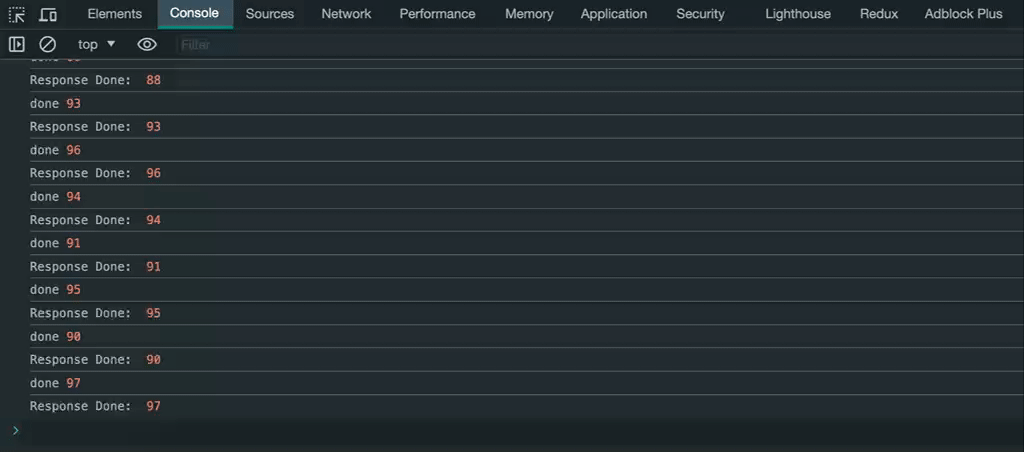First, let’s simulate the 100 requests:
| |
Promise.all()
Upon first encountering this problem, most people would likely think of Promise.all, as it is the most common way to handle concurrent requests. Let’s implement it:
| |
The result:

Each time, 10 requests are sent concurrently. Once these 10 requests are completed, the next 10 requests are sent, perfectly fulfilling the requirement.
However, a new question arises: what happens if one of these requests fails?

If there’s a failure in one request, the entire Promise.all fails without returning any value. If one request in a group fails, it becomes impossible to retrieve the return values of the other members in that group. While this may be acceptable in scenarios where return values aren’t necessary, in actual business practices, return values are crucial data.
We can tolerate the lack of a return value from a failed interface, but it’s unacceptable for a failure in one request to result in no return values for the other 9 requests in the same group.
Given that a failed request interrupts Promise.all, is there a method to avoid being disrupted by failures?
Indeed, there is — it’s called Promise.allSettled!
Promise.allSettled()
Let’s take a look at the introduction from MDN.
The
Promise.allSettled()method is one of the promise concurrency methods.Promise.allSettled()is typically used when you have multiple asynchronous tasks that are not dependent on one another to complete successfully, or you’d always like to know the result of each promise.
Replace Promise.all() with Promise.allSettled():
| |
The result:

As can be seen, when all interfaces return values normally, the return values will accurately record whether the current request succeeded or failed.
New question: If one request is very time-consuming, the response of that group of requests will be slow, blocking subsequent concurrent interface calls.
Analyse:
Using Promise.all() or Promise.allSettled() to concurrently handle 10 requests at a time can indeed meet concurrency requirements, but the efficiency is low. If there is one or more slow interfaces, two problems will occur:
The return of the concurrent group with the slow interface will be very slow; one slow interface delays the other nine, which is counterproductive.
Although we are capable of handling 10 concurrent requests, a slow interface causes the other nine concurrent slots in that group to be wasted, which cruelly extends the concurrency time for these 100 interfaces.
The subsequent concurrent groups behind the slow interface group are all blocked, making it even slower.
Solution:
A running pool and a waiting queue can be maintained, always keeping 10 requests concurrently in the running pool.
When one request in the running pool is completed, a new request is taken from the waiting queue and placed into the running pool to run, thus ensuring the running pool is always operating at full capacity.
Even if there is a slow interface, it will not block subsequent interfaces from entering the pool.
| |
The result:

As can be seen, the 100 interfaces are executed continuously without any waiting or blocking.
Summary
This article mainly summarizes methods to limit concurrency for 100 requests:
Promise.all()is the simplest way to control concurrency, but if a request fails, that group will not return a value.Promise.allSettled()solves the issue ofPromise.all(), but it suffers from slow interfaces blocking subsequent requests and wasting other concurrent slots.By maintaining a running pool, when a request in the pool completes, a new request is taken from the waiting queue and added to the pool for execution until all requests have entered the pool.
